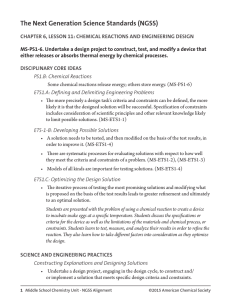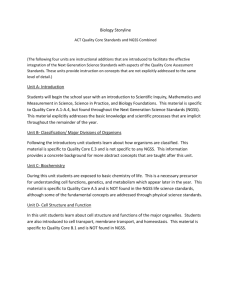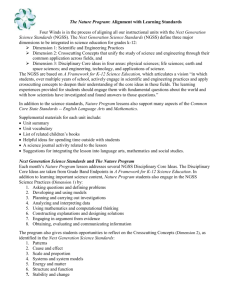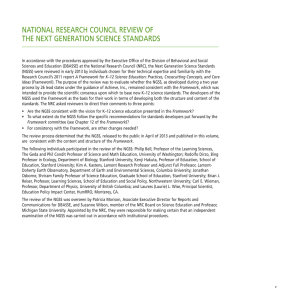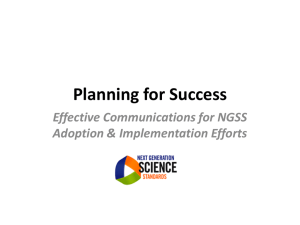T Where are we now and what have we learned?
advertisement
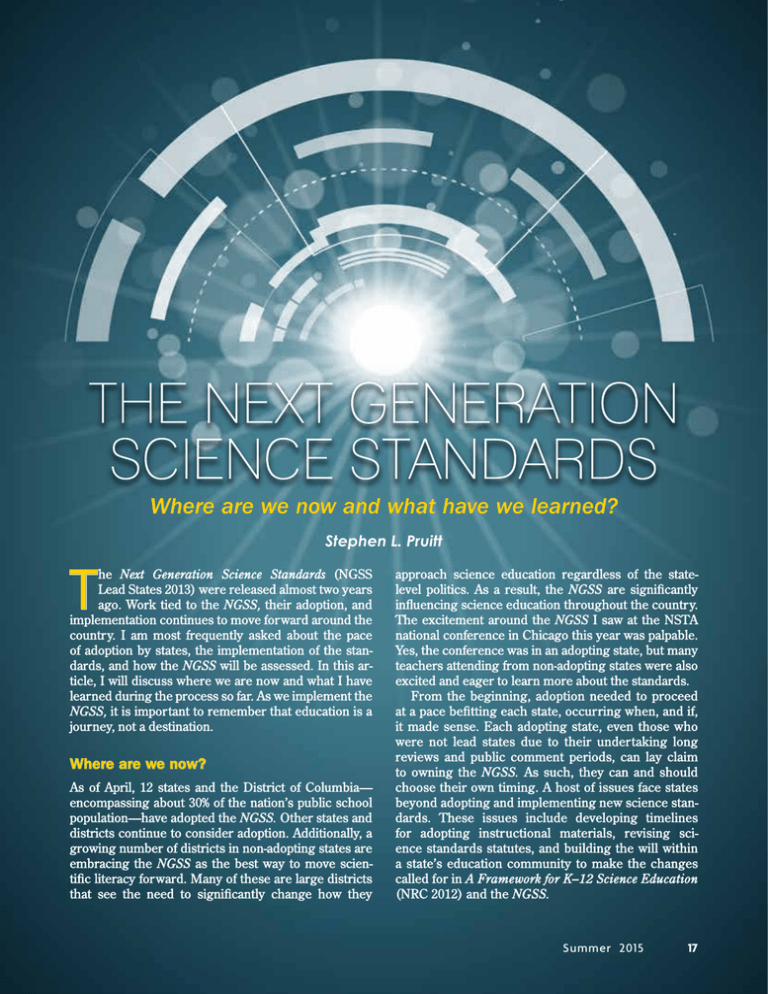
Where are we now and what have we learned? Stephen L. Pruitt T he Next Generation Science Standards (NGSS Lead States 2013) were released almost two years ago. Work tied to the NGSS, their adoption, and implementation continues to move forward around the country. I am most frequently asked about the pace of adoption by states, the implementation of the standards, and how the NGSS will be assessed. In this article, I will discuss where we are now and what I have learned during the process so far. As we implement the NGSS, it is important to remember that education is a journey, not a destination. Where are we now? As of April, 12 states and the District of Columbia— encompassing about 30% of the nation’s public school population—have adopted the NGSS. Other states and districts continue to consider adoption. Additionally, a growing number of districts in non-adopting states are embracing the NGSS as the best way to move scientific literacy forward. Many of these are large districts that see the need to significantly change how they approach science education regardless of the statelevel politics. As a result, the NGSS are significantly influencing science education throughout the country. The excitement around the NGSS I saw at the NSTA national conference in Chicago this year was palpable. Yes, the conference was in an adopting state, but many teachers attending from non-adopting states were also excited and eager to learn more about the standards. From the beginning, adoption needed to proceed at a pace befitting each state, occurring when, and if, it made sense. Each adopting state, even those who were not lead states due to their undertaking long reviews and public comment periods, can lay claim to owning the NGSS. As such, they can and should choose their own timing. A host of issues face states beyond adopting and implementing new science standards. These issues include developing timelines for adopting instructional materials, revising science standards statutes, and building the will within a state’s education community to make the changes called for in A Framework for K–12 Science Education (NRC 2012) and the NGSS. Summer 2015 17 Any teacher will tell you that adopting and implementing the NGSS cannot be done without a way to assess. Given the political climate around assessments, the conversation can be harrowing. As a key first step, the NGSS adopter states are committed to building classroom capacity. The focus has been, and must be, on classrooms first rather than building a test. The more we focus on educators and how to make the NGSS real in classrooms before developing an assessment, the better. Assessments that support classroom practice will come as we learn more from classroom experience. The way the NGSS outlines how students show proficiency makes sense, so teachers are embracing it. That doesn’t mean everyone is an expert. (Research from various places, including The Cambridge Handbook of Expertise and Expert Performance [Ericsson et al. 2006], show that it takes many hours of practice before expert thinking is acquired.) But it does mean that change is in the air, and we must learn more to do better for our students. It’s time to move from valuing what we measure to measuring what we value. In Kentucky, for instance, the state department of education has hired a “thought partner” before awarding assessment contracts to ensure that any new assessment fully assesses the NGSS. California is using a similar structure with two different groups as they consider new science assessments. So, I am encouraged with the direction and pace of implementation. A thoughtful and deliberate approach has always made the most sense. It is tough to have the courage to be patient, but it is a necessity, not for the adults but for the students. What have we learned? My presentation at NSTA’s national conference focused on the top 10 things I learned in 2014 through working with educators and state staff on the various issues we confront. Here are the 10 things, in no particular order: 1. Eliminating the black box is tough. A black box is created when current science learning is predicated on future science learning. This means that when you say to your students, “You will not understand this until next year,” you create a mystery rather than understanding. The NGSS provides an opportunity to look at science instruction coherently by connecting the different disciplines to better understand a phenomenon, removing the black box. Understanding the role of photosynthesis in the cycling of matter, for example, means you must understand a little about physical sciences in terms of matter and Earth science in terms of distribution of matter. 18 The Science Teacher 2. Teaching topics vs. understanding phenomena. Teaching science is about helping students understand the world around them, both natural and designed. Teaching topics like gas laws, volcanoes, or photosynthesis without connecting them to core ideas that help students explain the world provides no reason for them to learn or retain that information. Gas laws describe part of the structure and properties of matter. The deeper understandings of gas laws are found in the NGSS, but they are couched in explaining the bigger picture of structure of matter. The understandings needed for gas laws are spread throughout the years and across three core ideas in high school physical science. Understanding forces, energy, distribution of energy, and interactions of particles is far more powerful in explaining the world than simply calculating Charles’s law. 3. Simply reading the NGSS does not lead to NGSS expertise. In our work with the Educators Evaluating the Quality of Instructional Products (EQuIP) rubric, we have seen that professional development that dwells only on the NGSS does not help educators see the innovations required in the NGSS. So, having educators engage in EQuIP, curriculum design, task design, or even an intense discussion of standards that preceded the NGSS stimulates greater understanding. Professional development should also push educators to think outside their grade band and discipline when considering the NGSS (see numbers 9 and 10). 4. If you can eat it, it’s probably not a model. Understanding the science and engineering practices takes time. There are traditional “models” in classrooms across the country of which I imagine about 80% are edible. Models that students construct and use for the NGSS classroom are quite different. Students need to use models to explain or predict phenomena using evidence. Most “edible” models do not allow for that experience. Scientific and engineering practices are what students do, not teaching strategies. Students should be THE NEXT GENERATION SCIENCE STANDARDS able, for example, to identify the components of a model, articulate the relationship of those components, and explain or predict future phenomena based on the model. For more information, see the Appendix of the Evidence Statement (www. nextgenscience.org/ngss-highschool-evidence-statements). 5. Crosscutting concepts are still the third dimension. The NGSS have three dimensions: scientific and engineering practices, crosscutting concepts, and disciplinar y core ideas. Crosscutting concepts are still the hardest dimension to implement but also incredibly powerful. This dimension helps students connect what they learn to the world around them in a meaningful way. It’s hard, but clear instruction about how crosscutting concepts fit with the other dimensions will change science education. 6. Phenomena are underplayed and underappreciated. The Framework and the NGSS are very focused on phenomena. We need to bring the wonder back to science classrooms, which can be done through studies of phenomena. We have found this is tough to do because of our conditioning, but it is essential to making science real to students. 7. Bundling is not easy. Bundling performance expectations in the study of phenomena is critical to painting a coherent science picture for students. There is no single correct way to bundle, rather it must make sense to the teacher. So, pick a phenomenon and look at all the standards to find a way to better explain the world. Discuss it with colleagues. Bundling will only get easier with discussion and practice. 8. Communicate, communicate, communicate and then communicate some more. The NGSS represent a lot of what we want science classrooms to be, but they also depart from how most of our parents were taught. We must make every attempt to be clear about purposes, development processes, and how the NGSS will better prepare our students for the world. 9. Leadership makes the difference. Teachers make the difference in classrooms. It is time we realize that our profession also makes a difference in society. Teachers are leading the way to our future. What we see in states and districts that are effectively implementing the NGSS is that teachers and administrators are assuming greater leadership roles. Yes, there is more to learn and, yes, it is not easy, but the early implementers have shown us that quality leaders make the difference. 10. 3-D Learning is hard. We do not help teachers or students by pretending it’s not. If anyone claims to know everything about the threedimensional learning embodied in the NGSS, be skeptical. This is hard. But, like other professions that deal with hard changes, we will surmount these challenges, too. Learning how to create a 3-D culture in our classrooms takes time and effort. As was mentioned earlier, achieving expertise (thinking like an expert) takes many hours. We teachers should, as engineers do, give ourselves time to learn and room to grow. We will not get it right the first time, and that is okay. We will get better at NGSS instruction, but we must first acknowledge that it will take time and we will have varying degrees of initial success. The NGSS represent a great opportunity for students and science education. To me, they also represent a great opportunity for teachers to teach science the way we know we should and to be real leaders as we prepare our students for the future. ■ References Ericsson, K.A., N. Charness, P.J. Feltovich, and R.R. Hoffman, eds. 2006. The Cambridge Handbook of Expertise and Expert Performance. Cambridge, United Kingdom: Cambridge University Press. National Research Council (NRC). 2012. A framework for K–12 science education: Practices, crosscutting concepts, and core ideas. Washington, DC: National Academies Press. NGSS Lead States. 2013. Next Generation Science Standards: For states, by states. Washington, DC: National Academies Press. Stephen L. Pruitt (spruitt@achieve.org) is senior vice president, science, at Achieve, an independent, nonpartisan, nonprofit education reform organization that was a lead partner in developing the Next Generation Science Standards. Summer 2015 19



